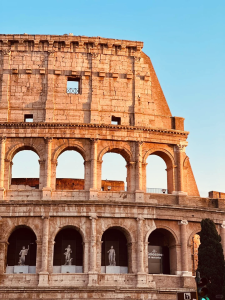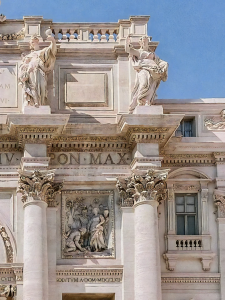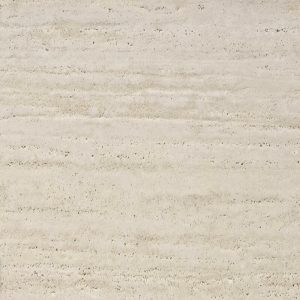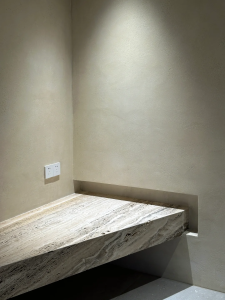Travertine Introduction
Travertine, often distinguished between white and beige varieties, comes in lighter and darker shades, sometimes called yellow or white “cave stone” in English. In geological terms, it is known as tufa or limestone. Its main characteristic is the presence of gas during the deposition of carbonate minerals, which leads to the formation of numerous cavities, hence the name.
As a terrestrial sedimentary rock, travertine is a deposit of calcium carbonate. During the process of heavy accumulation, pores can sometimes form, and due to its primary composition of calcium carbonate, it is naturally susceptible to dissolution and erosion by water. This results in many natural, irregular cavities within the deposits. These cavities are not only a distinctive feature but also the most beautiful aspect of the stone.
Commercially, it is categorized as marble. The use of this stone dates back to ancient times and is one of the most iconic representations of Roman culture. For centuries, travertine has been used as a building material. The Romans utilized it for temples, baths, and theaters. It can be seen in many historically significant monuments around the world, such as the Colosseum, St. Peter’s Basilica, and the Trevi Fountain.
Colosseum: Standing in the midst of what was the epicenter of an empire, the Roman Colosseum, remains an emblem of the legacy of the Roman Empire. Built from the finest travertine mined from areas in central Italy, the Colosseum wouldn’t be the same structure it is if it was constructed with something other than durable, natural material.
Fontana di Trevi: One of the most famous fountains in the world, the Trevi Fountain in Rome is an unmissable sight when visiting the romantic city. Built using local Travertine stone in 1762, Trevi Fountain stands 26 feet tall and 49 feet wide.

St. Peter’s Basilica: Saint Peter’s colonnade is an example of a monumental architectural work made entirely of Roman travertine. The sheer elegance of the columns expresses a high aesthetic value and is inseparable from the natural stone’s intrinsic qualities of compactness and resistance.

5 Travertine Choices for Timeless Building Projects
Traverse through the ages with our selection of five timeless Travertine choices, each a testament to enduring elegance and architectural beauty. These stones have been cherished for centuries, chosen for their ability to withstand the test of time while enhancing the aesthetic of any building project. Stay tuned as we introduce the following five choices, each selected for their timeless appeal and ability to elevate the grandeur of your building projects.
1.Roman Classic Travertine
It has a tradition going back to the Roman Empire, where it was utilized extensively in the building of famous sites such as the Colosseum. One particularly beautiful and durable kind of limestone created by mineral springs is travertine. Examining its historical importance and contemporary usage, this page explores the features, uses, and management of this ageless stone.
2.Red Travertine
Primarily from Iran, it is produced by the precipitation of calcium carbonate left by mineral springs. The characteristic reddish-brown coloring and the possibility of tiny, dispersed pores on its surface give this sedimentary rock its own look and texture. It comes in subtle blush tones as well as deep, rich reds, frequently with elaborate natural patterns that provide visual appeal and character. Any area is made cozier by its warm tones, which also provide a dramatic contrast with colder colors or materials.


3. Silver Grey Travertine
It is a natural stone that captures the essence of modern design with its sleek, neutral tones. Originally from areas like Turkey and Mexico, this stone is appreciated for its adaptability and strength. Modern homes and exteriors often choose it because of its subdued gray color palette, which accentuates natural veining and gives any area a refined touch. It’s understated elegance and simplicity improve the look of any project whether it is used as flooring, feature wall, or outdoor use. Both homeowners and designers should make intelligent investments in this stone since good sealing and care guarantee its beauty and usefulness over time.


4.Super White Travertine
It is a stone that has captivated the attention of builders and designers all over the world. It is a stone that is immaculate and elegant, and it originates from the picturesque regions of Italy. This natural stone, which is characterized by its brilliant white color and fine veining, lends an air of sophistication and elegance to any area within the building.


5.Valencia Traonyx Travertine
It is a high-quality natural stone originating from the esteemed quarries of Spain. Renowned for its arresting designs and rich, warm beige and gold tones, it gives any room an opulent look. For flooring, wall cladding, and as a decorative accent in counters and backsplashes, this adaptable stone finds great usage in both homes and businesses. It is a well-liked choice for designers and homeowners looking to create classic, sophisticated interiors because of its special mix of beauty and strength.
Travertine Application in Kitchen
Why Choose a Travertine Kitchen Island?
The designer and some homeowners both love Travertine, and the overall style of the house is tranquil. The fine pores and layered stone patterns of travertine, along with its low contrast, fit the decoration style perfectly. Combined with spotlight effects, the outcome is beyond expectations, creating an ethereal and fairy-like atmosphere.
Is Maintenance Difficult? There is a certain level of difficulty, as marble is a natural stone with not very high density. During the selection phase, I tested two samples; soy sauce left a stain that couldn’t be wiped off after sitting for an hour. I also try to avoid chopping chicken and pork bones on it. However, I can’t resist its beauty. Knowing this in advance and adjusting expectations can double the joy. By the way, my amazing designer used durable artificial stone on the side against the wall for me to freely use, showing attention to detail and thoughtfulness.
How to Maintain Travertine?
- Apply a protective film.
- Seal with matte glaze (the supplier was particularly responsible; I originally only needed a transparent seal for the holes, but they added matte glaze).
- Use a special solution advertised to prevent seepage (I’ve bought it but haven’t tried it yet; those interested can save it for later and wait for my results).
Some Insights on Using Travertine in the Kitchen
- Aligning Travertine Patterns: It’s crucial to keep the travertine’s veining consistent with the long edges of the installation area. Travertine tends to have a more linear pattern, and the direction of these lines is significant. If laid incorrectly, it can make the space appear cramped and disorganized. The same principle applies to other similar types of stone or slabs.
- Travertine in the Kitchen: Consider a protective film: The manufacturer mentioned they hadn’t previously used it in kitchens. For practicality, the natural stone in the kitchen was polished to a glossy finish to mitigate staining issues. However, this resulted in an unattractive reflective wall. After much thought, I decided on a protective film. This not only helps prevent staining to some extent but also addresses the issue of glossiness, giving the surface a more premium feel. In my case, the protective film was applied before the adhesive, preventing issues with peeling edges.
- Challenges with a Protective Film near the Stove: One issue with the protective film is that it can be easily damaged if placed too close to the stove. A stainless steel shield is being considered as a potential solution to this problem.
-
Economical and Stylish Travertine Overhang: If marble countertops are too thin, they can appear insubstantial from the side. Thus, I opted for a travertine overhang on the countertop. Although the base material of the countertop is still 1.8 cm thick, the side overhangs by 3 cm, creating the visual effect of a much thicker stone. However, this requires careful planning in the initial design phase of the kitchen cabinets, considering the height and other aspects.
Sintered Stone or Natural Travertine?
I was torn between sintered stone and natural travertine, but after receiving the samples, I decisively chose the natural stone. Natural stone has unique patterns and textures that are perfect for creating a natural, high-end atmosphere at home, but it requires a good foundation to prevent chipping and color seepage. Sintered stone is easy to clean, durable, and suitable for those who don’t want to spend effort on maintenance, but its patterns and textures are average. — Insight of my friend who is renovating her kitchen.
( The left is the Sintered Stone Kitchen Countertop, and the right one is the Travertine Kitchen Countertop)
| Feature/Material | Sintered Stone | Travertine |
|---|---|---|
| Composition | Engineered from natural stone particles and other raw materials, sintered under high pressure and heat. | Natural limestone is formed by mineral springs, with a porous structure. |
| Appearance | Consistent color and pattern due to the manufacturing process. | Varied appearance with unique patterns and color variations due to its natural formation. |
| Durability | High durability due to the sintering process, which makes it denser and less prone to chipping or cracking. | Moderate durability can be susceptible to chipping and cracking if not properly maintained. |
| Porosity | Low porosity, reducing the need for sealing and making it more resistant to stains. | High porosity, requiring regular sealing to prevent stains and moisture absorption. |
| Maintenance | Low maintenance due to its non-porous surface and resistance to stains. | Higher maintenance requires regular sealing and more care to prevent staining and damage. |
| Resistance | Resistant to frost, heat, and UV rays, suitable for both indoor and outdoor applications. | Less resistant to UV rays, which can cause fading, and not frost-proof, making it less suitable for outdoor use in colder climates. |
| Customization | Can be produced in a wide range of colors and patterns, offering more design flexibility. | Limited to natural patterns and colors, which can vary from one piece to another. |
| Environmental Impact | Often made from recycled materials, contributing to a lower environmental footprint. | Natural material, but the extraction process can have environmental impacts. |
| Cost | Generally more cost-effective than high-end natural stones due to their engineered nature and lower production costs. | Can vary widely depending on the quality and source of the natural stone. Higher-end travertine may be more expensive. |
| Applications | Suitable for a wide range of applications including flooring, wall cladding, countertops, and outdoor paving. | Traditionally used for flooring, wall cladding, and decorative elements, but less common for outdoor use due to its porosity. |
Travertine Tray

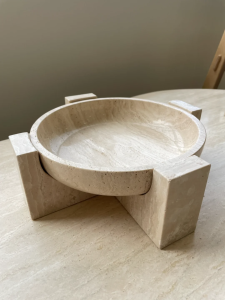

Why Customers Seek Travertine Trays:
1. Natural Beauty with a Unique Touch: Travel the wonders of nature using a Travertine Tray. Every tray presents a canvas of natural beauty highlighting the unique veining and color range of the stone. Every tray is a one-of-a-kind work since natural stone has unique patterns. This natural look appeals to consumers since it gives every area a cozy atmosphere and distinguishes their houses with a bit of the natural beauty of the soil.
2. Durability and Timeless Appeal: Customers search for trays made of natural stone mostly because of their durability, which is really important. Because of the stone’s durability, a Travertine Tray is not only a decorative item but also a long-lasting one able to resist daily use pressures. Its classic beauty also guarantees that these trays never go out of style, therefore transforming into a treasured possession to be enjoyed for several generations.
3. Versatility in Functionality and Design: The adaptability a Travertine Tray provides is much valued by consumers. Its functions are limited only by one’s imagination, whether they be as a chic base for a centerpiece, a useful catch-all for daily objects, or a sophisticated serving tray for hosting visitors. From minimalist modern to rustic chic, the tray’s neutral tones and natural patterns make it a flexible design piece that can accentuate a variety of decor styles, therefore enhancing any home’s appeal.
Is the Travertine Table the Trend for 2024?
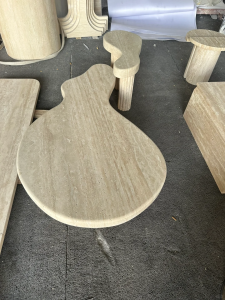

Is travertine filled or unfilled?
In the context of construction and design, travertine can come in both filled and unfilled forms, each with its own set of characteristics and recommended uses:
Unfilled Travertine:
- Unfilled travertine has not undergone any process to fill its natural pores and holes.
- It showcases the stone’s natural beauty in all its rugged and organic detail.
- This type is best suited for vertical applications such as wall cladding or backsplashes, where the integrity of the stone’s surface isn’t compromised by weight or frequent use.
- Because it retains its natural porosity, unfilled travertine may require sealing to protect against moisture and staining, emphasizing the need for proper maintenance.
Filled Travertine:
- Filled travertine has its holes and imperfections filled with a material that matches the stone, often using a mixture of stone dust and resin.
- This process reduces the stone’s natural texture and makes the surface smoother, providing a more consistent look.
- It is recommended for horizontal surfaces, like countertops or coffee tables because the filled areas offer additional strength and resistance to daily wear and tear.
- It is also lower maintenance in terms of sealing, as the filling material can make the surface less porous and more resistant to stains.
When incorporating this natural stone into your design, choosing between filled and unfilled it depends not only on the application but also on the desired aesthetic and the level of maintenance you’re willing to commit to. Filled travertine offers a polished and durable option for high-use areas, while unfilled one brings a more natural and textured look to vertical surfaces.
Why Opt For Xiamen Funshine Stone?
- Our design consultation service at Funshine Stone gives our customers peace of mind, high-quality stone, and professional guidance. Our expertise lies in natural stone design tiles, and we offer comprehensive “top to bottom” consulting to realize your idea.
- With a combined 30 years of project expertise, we have worked on a vast array of projects and established enduring relationships with numerous people.
- With a huge assortment of natural and engineered stones, including marble, granite, bluestone, basalt, travertine, terrazzo, quartz, and more, Funshine Stone is pleased to provide one of the largest selections available. It is clear that our use of the best stone available is superior.









